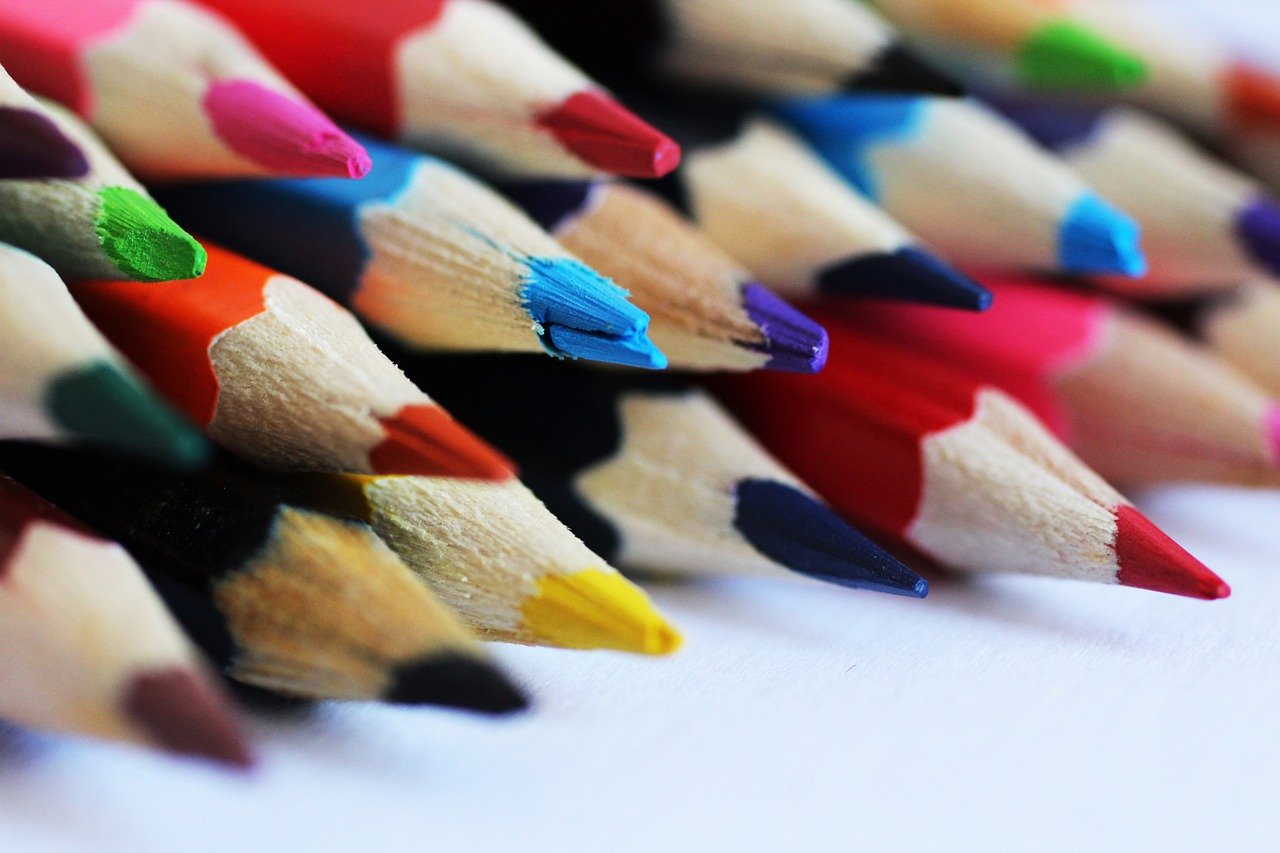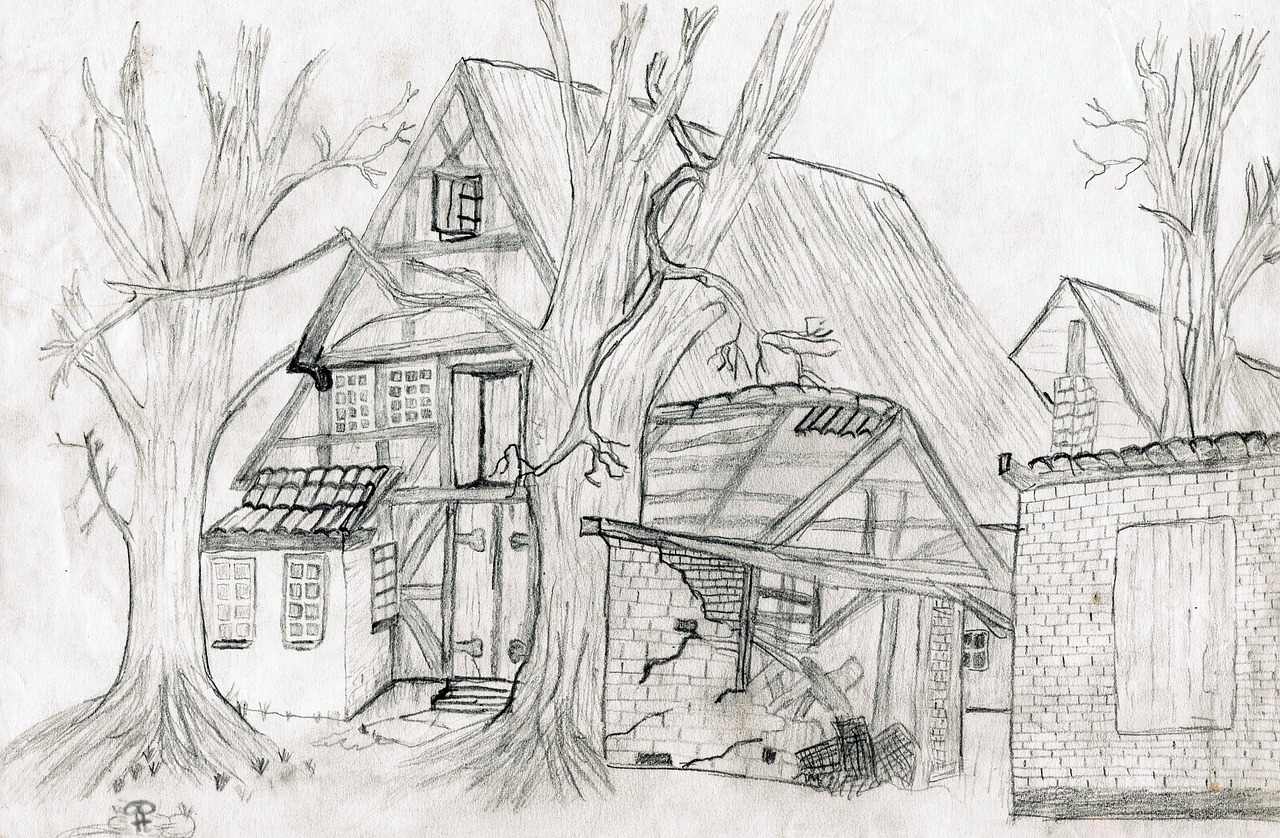Unlocking the Secrets of Perspective Drawing
Have you ever looked at a drawing and felt like you could step right into it? That magical sensation is all thanks to the art of perspective drawing. This technique allows artists to create the illusion of depth and space on a flat surface, transforming a simple piece of paper into a three-dimensional world. In this article, we’ll explore the fundamental principles of perspective drawing, the various techniques you can master, and practical applications that will elevate your artistic skills. So grab your sketchbook and let’s dive into this captivating subject!
To truly grasp perspective drawing, it's essential to understand its basic components. At the heart of this technique are three critical elements: vanishing points, horizon lines, and scale. The horizon line represents the viewer's eye level, while vanishing points are the spots on the horizon where parallel lines appear to converge. Imagine standing on a long, straight road; the edges of the road seem to meet at a point in the distance—this is your vanishing point!
Scale is equally important; it helps artists depict objects in relation to one another, creating a sense of realism. When you understand how these elements work together, you’ll be well on your way to crafting stunning, realistic images. Remember, perspective drawing is like building a house: you need a solid foundation to support everything else!
Now that we've covered the basics, let’s explore the different types of perspective. Each type offers unique ways to represent depth and dimension in your artwork. The three primary types are:
- One-Point Perspective
- Two-Point Perspective
- Three-Point Perspective
Each of these perspectives has its own characteristics and applications, making them invaluable tools in the artist's toolkit.
One-point perspective is perhaps the simplest form of perspective drawing. In this technique, all lines converge at a single vanishing point on the horizon line. This method is especially effective for creating depth in straightforward compositions, such as a long hallway or a straight road. Think of it as looking down a tunnel; everything appears to lead toward that one point in the distance.
This technique is incredibly versatile. Here are a few scenarios where one-point perspective shines:
- Interior scenes (like a room with a door at the end)
- Roadways and train tracks
- Simple landscapes
By mastering one-point perspective, you can create immersive environments that draw your viewers in.
While one-point perspective is straightforward, artists often fall into common traps. Here are a few pitfalls to avoid:
- Inconsistent horizon lines
- Ignoring scale differences between objects
- Misplacing vanishing points
By recognizing these mistakes, you can enhance the accuracy and impact of your drawings.
Two-point perspective takes things up a notch. Instead of one vanishing point, you have two, allowing for more dynamic and complex compositions. This technique is often used in architectural drawings and urban landscapes, where buildings and structures need to be depicted with realistic angles. Think of it as capturing a bustling city street from a corner vantage point, where the buildings recede toward two different points on the horizon.
Three-point perspective introduces a third vanishing point, which can be placed above or below the horizon line. This technique is perfect for capturing dramatic viewpoints and angles, such as looking up at a skyscraper or down from a high vantage point. It's like flying over a city and seeing the buildings shrink beneath you!
Three-point perspective can transform your artwork by enhancing the sense of scale and depth. It allows you to create engaging and dynamic viewpoints that can captivate your audience. Think of it as adding a thrilling twist to your storytelling—just like a plot twist in a great novel!
To truly master perspective drawing, practice is key. Here are a few exercises you can try:
- Draw a simple box using one-point perspective.
- Sketch a street scene using two-point perspective.
- Create a dramatic view of a tall building using three-point perspective.
These exercises will reinforce your understanding of perspective concepts and help you develop confidence in applying these techniques in your drawings.
Q: What is the best way to start learning perspective drawing?
A: Start with one-point perspective and gradually work your way up to two-point and three-point perspectives. Practice simple shapes and scenes to build your confidence.
Q: How can I improve my eye for perspective?
A: Observe real-life scenes and try to identify the vanishing points and horizon lines. Sketching from life can greatly enhance your understanding of perspective.
Q: Are there any tools that can help with perspective drawing?
A: Yes! Tools like rulers, T-squares, and perspective grids can be incredibly helpful in achieving accurate lines and angles.

Understanding Perspective Basics
When diving into the world of perspective drawing, it's essential to grasp the fundamental concepts that form the backbone of this artistic technique. Perspective drawing is all about creating the illusion of depth and dimension on a flat surface, allowing artists to represent three-dimensional space realistically. At the core of this practice are three critical elements: vanishing points, horizon lines, and scale.
The horizon line serves as the viewer's eye level, determining where the sky meets the ground in your artwork. Think of it as the boundary where reality and imagination collide. Every object in your drawing will relate to this line, influencing how it appears in relation to the viewer. For example, if you're sketching a landscape, the horizon line will dictate the placement of trees, mountains, or buildings, making them seem either towering or diminutive.
Next up are vanishing points. These are the magical spots on the horizon line where parallel lines seem to converge. Imagine standing on a long, straight road; the sides of the road appear to meet at a point in the distance. This is the essence of perspective! Depending on how many vanishing points you use, you can create different effects:
- One-point perspective utilizes a single vanishing point, perfect for straightforward scenes like hallways or railway tracks.
- Two-point perspective employs two vanishing points, ideal for capturing the complexity of buildings or urban environments.
- Three-point perspective introduces a third vanishing point, often placed above or below the horizon line, which is great for depicting tall structures or dramatic viewpoints.
Understanding scale is equally crucial. Scale refers to the size of objects in relation to each other and the overall composition. A small object placed close to the viewer can appear larger than a massive structure in the distance. This relationship creates a sense of realism and helps the viewer navigate the space you've created. For instance, when drawing a cityscape, ensuring that the buildings are proportionate to the figures walking below will enhance the depth of your drawing.
In summary, mastering the basics of perspective drawing involves a delicate balance of these elements. By effectively utilizing horizon lines, vanishing points, and scale, artists can transform flat images into captivating three-dimensional experiences. So, grab your pencil and paper, and let’s dive into the exciting journey of perspective drawing!
Q1: What is the difference between one-point and two-point perspective?
A1: One-point perspective uses a single vanishing point on the horizon line, making it suitable for straightforward compositions, while two-point perspective employs two vanishing points, allowing for more complex and dynamic scenes.
Q2: Can I use perspective drawing in digital art?
A2: Absolutely! Perspective drawing principles apply to both traditional and digital art, helping you create depth and realism in your digital illustrations.
Q3: How can I practice perspective drawing effectively?
A3: Start with simple shapes and gradually incorporate more complex scenes. Utilize grids and reference images to understand how perspective works in various contexts.

Types of Perspective
When it comes to perspective drawing, understanding the different types is essential for any artist or designer looking to create stunning visuals. Perspective is not just about making things look pretty; it’s about conveying depth and dimension in a way that feels natural and engaging. Each type of perspective has its unique characteristics and applications, which can dramatically influence the final outcome of your artwork. Let’s dive into the world of perspective and uncover the magic behind one-point, two-point, and three-point perspectives.
First up is one-point perspective. This technique is characterized by having a single vanishing point on the horizon line. Imagine standing at the end of a long, straight road; the edges of the road seem to converge at a point far away. This is the essence of one-point perspective. It’s straightforward yet incredibly effective for creating depth in simple compositions. You’ll often see this used in interior scenes or along straight corridors, where the lines of the walls, floors, and ceilings all lead to that singular vanishing point.
Next, we have two-point perspective. This method introduces a second vanishing point, which allows for more dynamic compositions. Picture a corner of a building where two walls meet; each wall has its own vanishing point on the horizon. This perspective is often utilized in architectural drawings and urban landscapes, as it adds a layer of complexity and realism. By using two vanishing points, artists can create a sense of movement and flow within their work, making the viewer feel as if they are stepping into the scene.
Finally, let’s explore three-point perspective. This technique takes things up a notch by adding a third vanishing point, typically placed above or below the horizon line. This perspective is fantastic for capturing dramatic viewpoints, such as looking up at a towering skyscraper or down from a great height. The added vanishing point creates a sense of elevation or depth that can be both exhilarating and overwhelming. It’s a powerful tool for artists who want to evoke strong emotions through their work.
To summarize, here’s a quick comparison of the three types of perspective:
| Type of Perspective | Vanishing Points | Characteristics | Common Applications |
|---|---|---|---|
| One-Point Perspective | 1 | Straightforward, simple depth | Interiors, roads, hallways |
| Two-Point Perspective | 2 | Dynamic, complex depth | Architectural drawings, urban landscapes |
| Three-Point Perspective | 3 | Dramatic viewpoints, exaggerated depth | Tall structures, aerial views |
Understanding these types of perspective is crucial for artists and designers alike. Each perspective offers unique ways to convey space and depth, allowing you to create more engaging and realistic artwork. By mastering these techniques, you can elevate your drawings from flat representations to immersive experiences that captivate your audience.
As you delve deeper into the world of perspective, remember that practice is key. Experiment with each type, and don't be afraid to push the boundaries of your creativity. The more you practice, the more natural these techniques will become, and soon, you’ll find yourself effortlessly incorporating them into your work.

One-Point Perspective
One-point perspective is like the magic trick of the art world; it draws the viewer into the scene with an inviting depth that feels almost real. Imagine standing at the end of a long hallway or gazing down a straight road; everything converges at a single point on the horizon. This technique is particularly effective because it simplifies the complexity of three-dimensional space into a manageable format. By utilizing a single vanishing point, artists can create a strong sense of depth and focus, making it an essential tool for anyone looking to enhance their artwork.
In one-point perspective, the horizon line represents the viewer's eye level, while the vanishing point is the spot where all parallel lines appear to converge. This is where the magic happens! The lines that lead to the vanishing point guide the viewer's eye into the drawing, creating a pathway that feels natural and engaging. For instance, when drawing a room, the walls, floor, and ceiling lines will all angle towards this singular point, giving the viewer the sensation of being part of the space.
To master one-point perspective, it is crucial to understand the role of scale. Objects closer to the viewer should appear larger, while those further away should diminish in size. This concept of scale is what lends realism to your drawings. Think of it as a visual illusion; the closer an object is to the viewer, the more detail and size it retains, while distant objects fade into the background. It’s a bit like how a magician uses misdirection to keep the audience guessing!
One-point perspective is not just limited to interiors or straight roads; it can be applied in various contexts, including:
- Interior Scenes: Capturing the essence of a room, where the walls lead the eye toward an inviting focal point.
- Roads and Pathways: Creating the illusion of distance and travel, where the road narrows as it approaches the horizon.
- Railway Tracks: Effectively illustrating the depth and length of tracks vanishing into the distance.
However, even the most skilled artists can stumble when using one-point perspective. Common mistakes include improper placement of the vanishing point, which can throw off the entire composition, or neglecting the scale of objects, leading to a flat and lifeless drawing. To avoid these pitfalls, always double-check your lines and ensure that they converge correctly at the vanishing point. Practice makes perfect, so don't be afraid to experiment with different compositions!
In conclusion, mastering one-point perspective is like learning to ride a bike; it may seem daunting at first, but with practice, it becomes second nature. This technique allows artists to create captivating scenes that draw the viewer in, making them feel as if they are stepping into another world. So grab your pencil, find your vanishing point, and start exploring the endless possibilities that one-point perspective has to offer!
Q: What is a vanishing point?
A vanishing point is a point on the horizon line where parallel lines appear to converge. It is essential in creating the illusion of depth in perspective drawing.
Q: Can I use one-point perspective for outdoor scenes?
Absolutely! While one-point perspective is often used for interiors, it can also be applied to outdoor scenes like roads, railways, and buildings viewed from a straight-on angle.
Q: How can I practice one-point perspective?
Start by sketching simple shapes like boxes or rooms. Gradually incorporate more complex scenes, ensuring all lines lead to your vanishing point.

Applications of One-Point Perspective
One-point perspective is a remarkable technique that artists and designers utilize to create a sense of depth and realism in their work. Imagine standing at the end of a long hallway, where the walls seem to converge into a single point in the distance; this is the magic of one-point perspective. It simplifies complex scenes, making it easier for viewers to grasp the spatial relationships within the artwork. This technique finds its applications in various fields, from fine art to architecture and even graphic design.
In interior design, one-point perspective is often employed to depict rooms and spaces. By positioning the viewer at the entrance of a room, designers can use this technique to create an inviting atmosphere that draws the eye toward the focal point, such as a beautiful piece of furniture or artwork. The lines of the walls and floor converge toward the vanishing point, guiding the viewer’s gaze and enhancing the overall composition.
Another fascinating application is in landscape drawing. Artists can depict roads, railways, or pathways leading into the distance, where they seem to vanish into the horizon. This creates a sense of journey or adventure, inviting the viewer to imagine what lies beyond the visible scene. It’s as if the artist is saying, “Come, let’s explore together!”
Moreover, one-point perspective is incredibly useful in creating immersive environments in video games and virtual reality. Game designers often use this technique to craft levels that feel realistic and engaging. By establishing a clear vanishing point, they can manipulate the viewer's experience, making them feel as though they're truly stepping into the game world.
To illustrate the versatility of one-point perspective, consider the following applications:
- Architectural Drawings: Used to depict buildings and interiors clearly, allowing for easy visualization of designs.
- Illustrations: Helps in creating storybook illustrations that guide readers' attention to key elements.
- Photography: Photographers often use this technique in framing shots to lead the viewer's eye through the image.
- Film and Animation: Directors use one-point perspective to establish depth in scenes, enhancing storytelling through visual cues.
In conclusion, one-point perspective is not just a drawing technique; it’s a powerful tool that artists and designers can wield to enhance their storytelling and engage their audience. Whether it’s in a serene landscape, a bustling cityscape, or an inviting interior, mastering this perspective can elevate your work to new heights.

Common Mistakes in One-Point Perspective
When diving into the world of one-point perspective, many artists find themselves grappling with a few common pitfalls that can undermine their efforts. Understanding these mistakes is crucial for anyone looking to enhance their skills and create more convincing artwork. One of the most frequent errors is misplacing the vanishing point. The vanishing point is the anchor of your composition, and if it's not positioned correctly—often too high or too low—it can skew the entire drawing, making it feel off-balance. Imagine trying to build a house on a shaky foundation; it just won’t hold up!
Another common mistake is neglecting the horizon line. The horizon line represents the viewer's eye level, and failing to establish it can lead to a disorienting experience for the viewer. When the horizon line is inconsistent or absent, it can create a sense of confusion, as if the scene is floating in space rather than grounded in reality. Remember, the horizon line is like the stage on which your drawing performs—without it, the scene lacks context.
Additionally, many artists overlook the importance of scale and proportion. When objects are drawn without considering their relative sizes, the sense of depth diminishes significantly. For instance, if you draw a large object close to the viewer without adjusting the size of objects further away, it can create a jarring effect. A good rule of thumb is to always compare sizes as if you were measuring them in real life, which helps maintain that illusion of depth.
Moreover, failing to apply converging lines can lead to flat and lifeless compositions. In one-point perspective, all lines should converge toward the vanishing point. If you draw parallel lines that don't meet at the vanishing point, your artwork will lose that dynamic depth that makes perspective drawing so captivating. Think of it like trying to capture the essence of a sunset; if you miss the colors blending into one another, the beauty is lost.
Lastly, artists sometimes forget to incorporate foreground, middle ground, and background elements effectively. By layering these elements, you can create a more immersive scene. Without this depth layering, your artwork may feel one-dimensional. To visualize this, think of a theater performance where the foreground actors are in sharp focus while the background sets create a sense of distance. This layering is essential for drawing the viewer into your world.
To summarize, avoiding these common mistakes can significantly enhance your one-point perspective drawings. Keep an eye on your vanishing point, horizon line, scale, converging lines, and the use of foreground and background elements. By being mindful of these aspects, you can elevate your artwork from flat and confusing to dynamic and engaging.
- What is the best way to practice one-point perspective? Regularly sketching simple scenes, such as a room or a street, while focusing on the vanishing point and horizon line can be very helpful.
- Can one-point perspective be used for complex subjects? Yes! While it’s often used for simpler compositions, you can certainly apply it to more complex subjects by breaking them down into simpler shapes.
- How do I know if my perspective is correct? A good way to check is to step back and view your drawing from a distance. If it looks convincing from afar, you're on the right track!

Two-Point Perspective
When it comes to capturing the essence of depth and dimension in your artwork, is like the secret sauce that adds flavor to your creations! Unlike one-point perspective, where everything converges at a single point, two-point perspective introduces a whole new level of complexity and dynamism. Imagine standing at the corner of a building, where two sides stretch away from you, each leading to its own vanishing point on the horizon. This technique not only enhances realism but also invites the viewer into the scene, creating a sense of immersion that is hard to resist.
In two-point perspective, you'll typically find that the vanishing points are placed on the horizon line, often off the canvas. This positioning allows for the depiction of objects viewed at an angle, making it particularly useful for architectural drawings and urban landscapes. By employing this method, artists can portray scenes that feel alive and full of movement. Picture a bustling city street, where the buildings rise majestically into the sky, drawing the eye along their lines towards the distant horizon. It’s almost like you can feel the energy of the city just by looking at it!
To master two-point perspective, it’s essential to understand the concept of orthogonal lines. These are the diagonal lines that lead from the edges of your objects to the vanishing points. They help establish the depth and direction of your scene. When drawing, start by sketching the horizon line and placing your vanishing points. Then, draw the vertical lines of your objects and connect them with orthogonal lines to the vanishing points. It’s a bit like building a bridge between your imagination and the paper, allowing your ideas to flow freely.
However, as with any artistic technique, there are some common challenges that artists face when working with two-point perspective. For instance, if the vanishing points are too close together, your drawing may appear distorted or cramped. Conversely, if they are too far apart, the scene might lose its sense of cohesion. It’s a delicate balance, much like walking a tightrope, where even a slight misstep can lead to an unbalanced composition. To avoid these pitfalls, practice is key. Try sketching simple objects, like boxes or buildings, before moving on to more complex scenes.
In addition to architectural applications, two-point perspective can be used in various other scenarios, such as:
- Creating dynamic landscapes
- Illustrating interior spaces
- Designing product packaging
Each of these applications benefits from the depth and realism that two-point perspective provides. Whether you're sketching a cozy room or a sprawling cityscape, the technique allows you to convey a sense of space that draws viewers in.
In conclusion, mastering two-point perspective is an essential skill for any artist or designer looking to elevate their work. By understanding the principles behind this technique and practicing regularly, you’ll be able to create stunning, immersive scenes that capture the imagination of your audience. So, grab your sketchbook and start exploring the world of two-point perspective—your artistic journey awaits!

Mastering Three-Point Perspective
When it comes to creating a sense of depth and realism in your drawings, three-point perspective is like adding a turbocharger to your artistic engine. This technique introduces a third vanishing point that can be positioned either above or below the horizon line, allowing artists to depict dramatic viewpoints and angles. Imagine standing at the base of a skyscraper, looking up; that feeling of awe and the towering presence of the building is what three-point perspective captures beautifully.
Mastering this technique is essential for artists who want to convey a sense of scale and grandeur in their work. It’s not just about placing lines; it’s about creating an entire world that feels alive and immersive. The beauty of three-point perspective lies in its ability to create a dynamic composition that draws the viewer into the scene. Whether you’re illustrating a bustling cityscape or the intricate details of a tall building, understanding how to manipulate these vanishing points is crucial.
To get started with three-point perspective, here are some key aspects to keep in mind:
- Vanishing Points: In three-point perspective, you have one vanishing point on the horizon and two others that are either above or below it. This setup creates a dramatic effect that can make objects appear to either tower above you or plunge below your feet.
- Horizon Line: Your horizon line will remain constant, but the placement of your additional vanishing points will vary depending on your viewpoint. This is where your creativity can shine!
- Scale and Proportion: Pay close attention to how objects scale relative to each other. The closer an object is to the viewer, the larger it should appear, while those further away will naturally diminish in size.
One of the most effective ways to practice three-point perspective is through sketching real-world scenes. Find a tall building or a structure with height and try to capture it using this technique. Start by establishing your horizon line and vanishing points. Then, sketch the outlines of the building, paying close attention to how the lines converge at the vanishing points. This exercise not only improves your technical skills but also enhances your observational abilities as an artist.
As you practice, you'll notice that three-point perspective opens up a world of creative possibilities. It allows you to portray scenes that feel expansive and full of life, making your artwork resonate with viewers on a deeper level. So, whether you’re an aspiring architect, a passionate illustrator, or just someone who loves to draw, mastering three-point perspective is a powerful tool in your artistic arsenal.
Utilizing three-point perspective can transform a mundane scene into a captivating visual experience. For instance, if you were to draw a street corner from a bird's-eye view, the way the buildings shrink into the distance can create a feeling of vastness. This technique can make viewers feel as though they are part of the scene, enhancing their emotional engagement with your artwork.
Moreover, three-point perspective is particularly useful in architectural drawings. It allows architects and designers to present their visions in a way that is not only realistic but also visually striking. By manipulating the vanishing points, they can emphasize certain features of a building, making them appear more prominent and inviting. This is especially effective in marketing materials where first impressions matter immensely.
In summary, mastering three-point perspective is not just about understanding the technicalities; it’s about harnessing the emotional power of perspective to create art that speaks to the viewer. As you continue to explore this technique, remember to keep experimenting and pushing the boundaries of your creativity.
Q: What is three-point perspective?
A: Three-point perspective is a drawing technique that uses three vanishing points to create a sense of depth and dimension, often used to depict tall structures or dramatic angles.
Q: How do I practice three-point perspective?
A: Start by sketching real-life tall buildings or structures. Establish your horizon line and vanishing points, and then draw the outlines of the structures, paying attention to how the lines converge.
Q: Can three-point perspective be used in digital art?
A: Absolutely! Three-point perspective can be effectively used in digital art, allowing artists to create dynamic and engaging compositions with ease.

Dynamic Viewpoints in Three-Point Perspective
Three-point perspective is like the secret sauce of depth and drama in your artwork. Imagine standing at the edge of a towering skyscraper, looking up. The buildings seem to stretch into the sky, and everything around you feels alive and vibrant. This is the magic that three-point perspective offers. By adding a third vanishing point, typically located either above or below the horizon line, you can create a sense of height or depth that simply isn’t possible with just one or two points.
When you incorporate three-point perspective into your drawings, you’re not just showing objects; you’re capturing their essence and how they interact with the space around them. This technique allows artists to depict dramatic viewpoints, such as looking up at a tall building or down from a great height. It’s like giving your audience a front-row seat to a visual spectacle! But how do you harness this power effectively?
To master dynamic viewpoints in three-point perspective, consider the following key elements:
- Vanishing Points: The placement of your three vanishing points is crucial. The two on the horizon line control the width and depth, while the third point, positioned vertically, influences height.
- Horizon Line: This line represents the viewer's eye level. Adjusting it can dramatically change the perspective of your drawing.
- Scale and Proportion: Objects closer to the viewer should appear larger, while those further away should be smaller. This principle helps to reinforce the three-dimensional feel.
Additionally, consider the angles you choose when drawing. The more extreme the angle, the more dramatic the effect. For example, an upward angle can make a building look imposing and grand, while a downward angle can give the viewer a sense of being on top of the world. Think of it as creating a narrative through your perspective; each angle tells a different story.
Practicing three-point perspective can initially feel like trying to juggle while riding a unicycle, but with time and patience, it becomes second nature. Start with simple shapes and gradually introduce more complex structures. Draw a box, then a building, and finally, try your hand at a bustling cityscape. Each step will build your confidence and skill, allowing you to create stunning visuals that leap off the page.
In summary, dynamic viewpoints in three-point perspective are all about experimentation and observation. By understanding how to manipulate vanishing points, horizon lines, and scale, you can create artwork that not only captivates but also transports your audience into a world of depth and intrigue. So grab your pencil, find a unique viewpoint, and let your creativity soar!
| Question | Answer |
|---|---|
| What is three-point perspective? | Three-point perspective is a drawing technique that uses three vanishing points to create a sense of depth and dimension, often used for depicting tall structures or dramatic viewpoints. |
| How do I create a three-point perspective drawing? | Start by establishing your horizon line and placing your two vanishing points on it. Then, add a third vanishing point either above or below the horizon line, depending on the viewpoint you want to achieve. |
| What are common mistakes to avoid in three-point perspective? | Common mistakes include misplacing the vanishing points, neglecting scale, and failing to maintain consistent angles. Practice and careful observation can help you avoid these pitfalls. |

Practical Exercises for Perspective Mastery
Mastering perspective drawing can feel like climbing a mountain, but with the right exercises, you can reach the summit with confidence and skill. One of the best ways to grasp the concepts of perspective is through consistent practice. Here are some engaging exercises designed to help you internalize the principles of perspective drawing:
First, start by drawing simple objects in one-point perspective. Take a rectangular box and place it in front of you. Draw the box as you see it, ensuring all lines converge at a single vanishing point on your horizon line. This exercise helps you understand how objects recede into space. Repeat this with various objects, like a table or a doorway, to get comfortable with the technique.
Next, move on to two-point perspective. Find a corner of a room or an intersection on a street. Draw the corner as if you were standing in the middle of it, with two vanishing points on your horizon line. This exercise will not only challenge you to think about depth but also enhance your ability to visualize complex shapes. You can even take photographs of buildings and try to recreate them in two-point perspective, which can be incredibly rewarding.
Don’t forget to incorporate three-point perspective into your practice. A fun exercise is to draw a skyscraper from below, looking up. Place your three vanishing points: two on the horizon line and one above. This will help you understand how height affects perspective, and you’ll create a striking image that captures the viewer’s attention.
Additionally, consider setting up a still life arrangement in your workspace. Use a variety of objects of different heights and shapes, and draw them from a vantage point that requires you to apply all three types of perspective. This will challenge your understanding of scale and proportion, as you will need to adjust the size of objects based on their distance from your eye level.
To further enhance your skills, engage in a daily sketching routine. Dedicate at least 15 minutes a day to drawing scenes around you, focusing on the perspective. Whether it’s a busy street, a cozy café, or your own living room, practicing regularly will solidify your understanding and improve your confidence.
Lastly, consider joining an art group or online forum where you can share your work and receive feedback. Engaging with other artists can provide you with new perspectives (pun intended!) and insights that can elevate your drawing skills. Remember, the journey to mastering perspective is ongoing, and every sketch is a step towards improvement!
Q: How long does it take to master perspective drawing?
A: Mastering perspective drawing varies for each individual. With regular practice, you can see significant improvements in a few weeks, but true mastery may take months or even years.
Q: What materials do I need to start practicing perspective drawing?
A: You can start with basic materials such as pencils, erasers, and sketch paper. A ruler can also be helpful for drawing straight lines and ensuring accuracy in your perspective.
Q: Can I use digital tools to practice perspective drawing?
A: Absolutely! Many artists use digital drawing software that has built-in perspective grids, making it easier to visualize and create complex perspectives.
Frequently Asked Questions
- What is perspective drawing?
Perspective drawing is a technique used to create the illusion of depth and space on a flat surface. By using vanishing points and horizon lines, artists can depict three-dimensional objects realistically, making their artwork more engaging and lifelike.
- What are vanishing points and horizon lines?
Vanishing points are points on the horizon line where parallel lines appear to converge, while the horizon line represents the viewer's eye level. Both are crucial in establishing the perspective in a drawing, guiding the viewer's eye and creating a sense of depth.
- What are the different types of perspective?
There are three main types of perspective: one-point, two-point, and three-point perspective. Each type uses a different number of vanishing points to create varying levels of depth and complexity in the artwork.
- How do I use one-point perspective effectively?
To use one-point perspective effectively, focus on placing all your lines towards a single vanishing point. This technique is great for simple compositions like roads or hallways, where the depth is straightforward and easy to convey.
- What are common mistakes in one-point perspective?
Common mistakes include misplacing the vanishing point, inconsistent scale, and neglecting to align objects correctly with the perspective lines. To avoid these issues, practice regularly and study existing works that utilize one-point perspective.
- When should I use two-point perspective?
Two-point perspective is ideal for drawing objects at an angle, such as buildings in urban landscapes. It allows for more dynamic compositions and gives a sense of realism that one-point perspective may not achieve.
- What is three-point perspective used for?
Three-point perspective is used for dramatic viewpoints, such as looking up at tall buildings or down from a high vantage point. It adds an extra layer of depth and can make your artwork more visually striking.
- How can I practice perspective drawing?
Engage in practical exercises like drawing simple shapes in different perspectives, using reference photos, or sketching real-life scenes. Consistent practice will help you master these techniques and build your confidence.
- Are there any tools that can help with perspective drawing?
Yes! Tools like rulers, protractors, and even digital drawing software can assist in creating accurate perspective drawings. Additionally, perspective grids can be incredibly helpful for beginners to visualize the concepts.



















